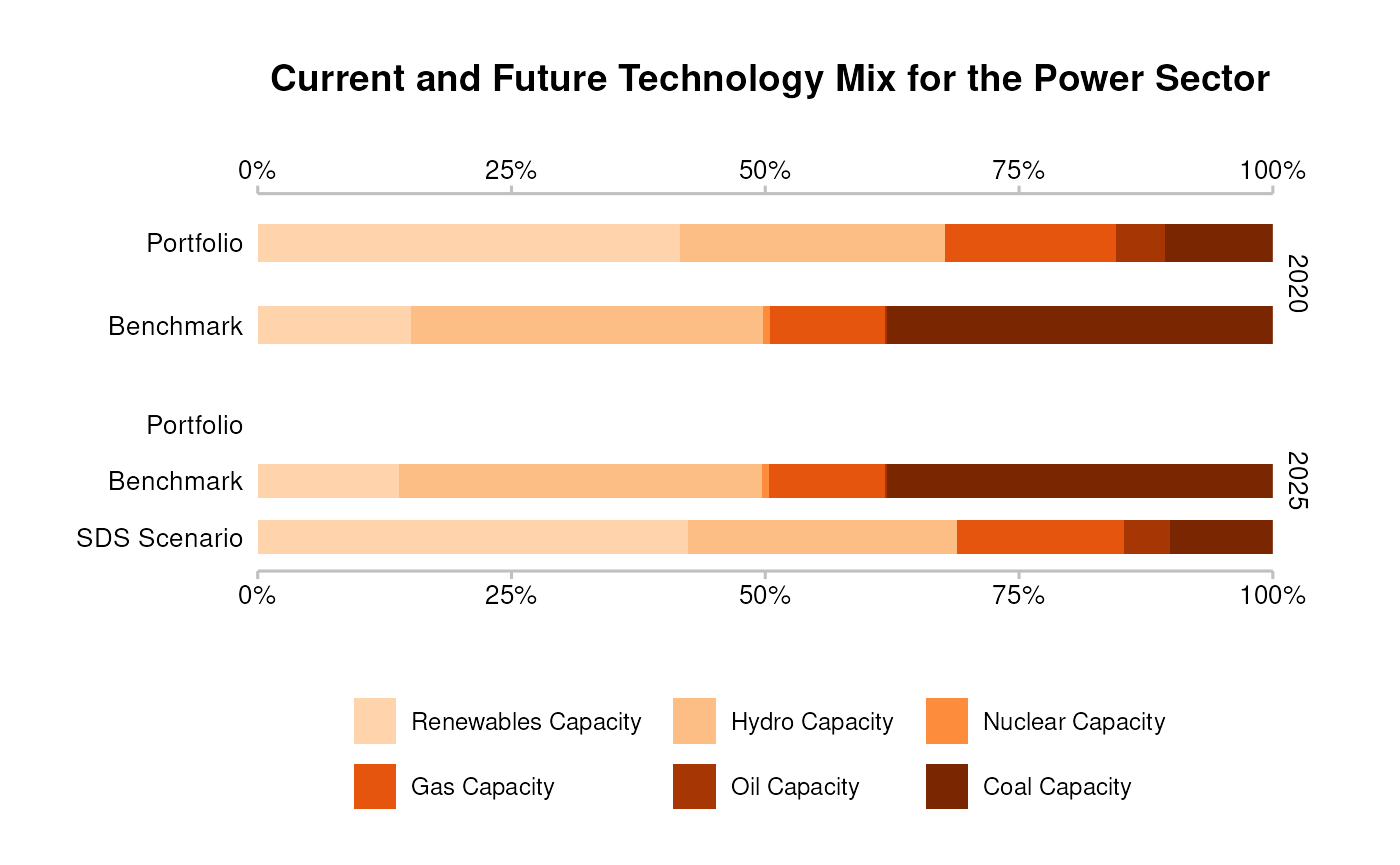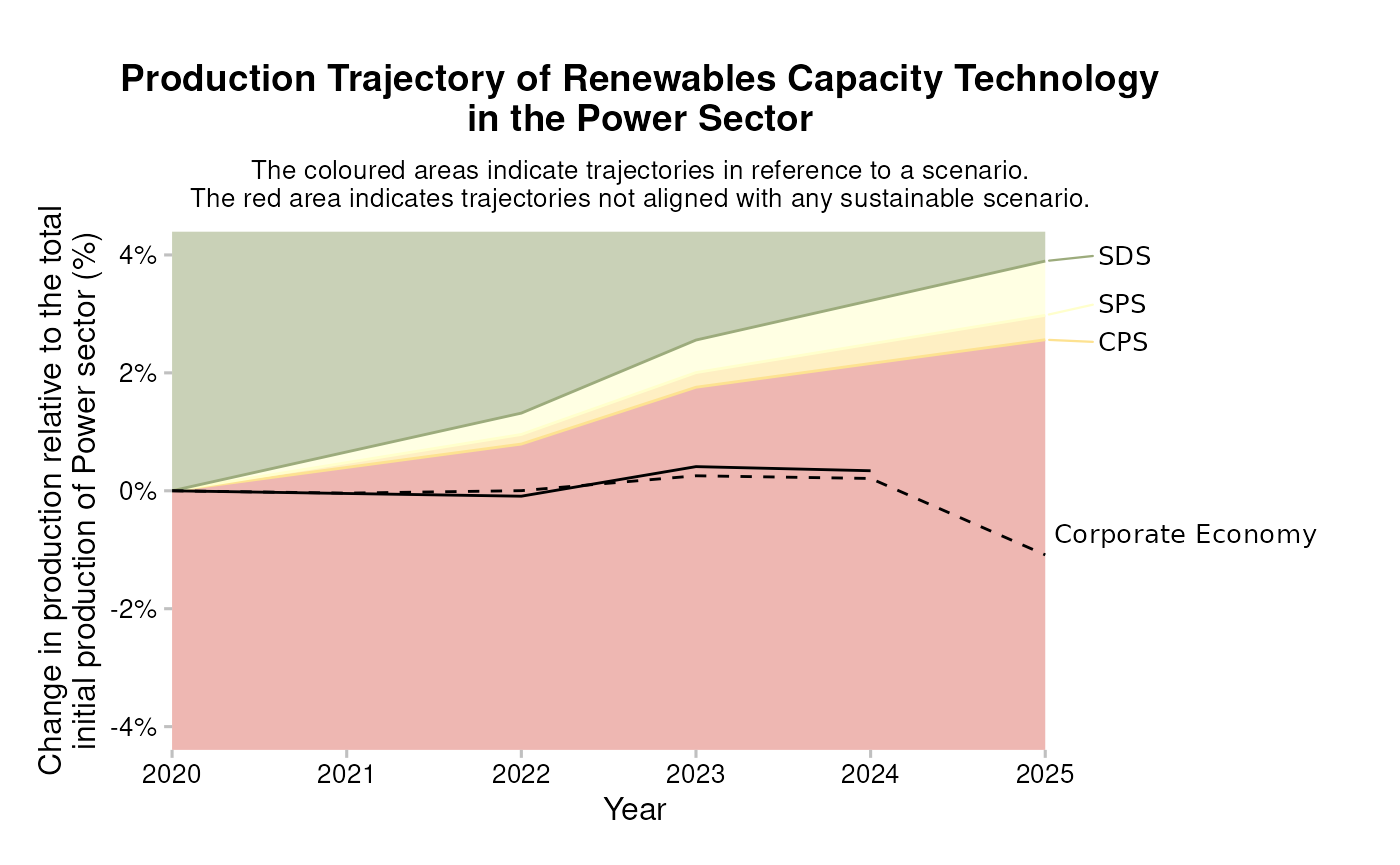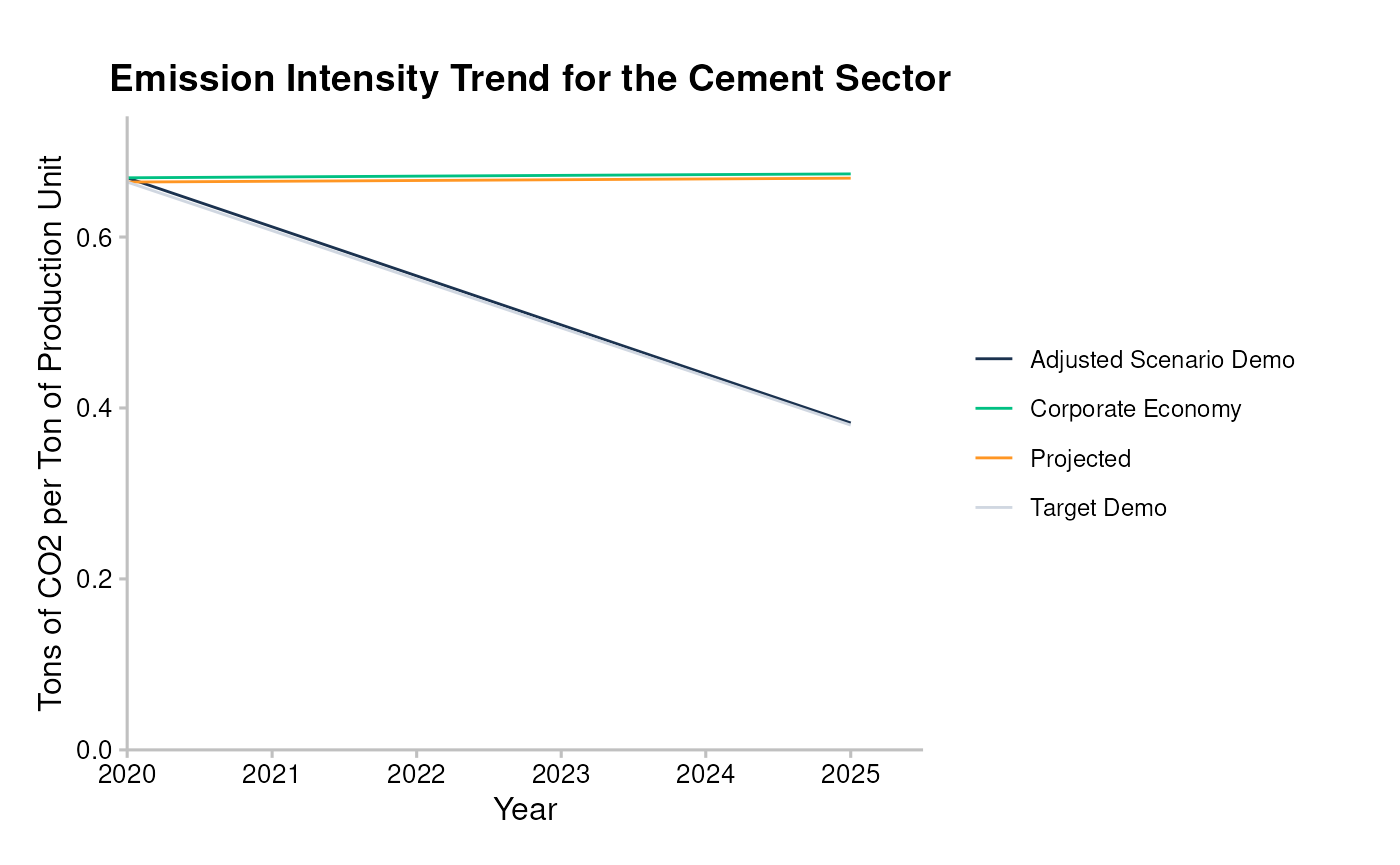Load your r2dii libraries
The first step in your analysis will be to load in the recommended r2dii packages into your current R session. r2dii.data includes fake data to help demonstrate the tool and r2dii.match provides functions to help you easily match your loanbook to asset-level data.
library(r2dii.data)
library(r2dii.match)
#>
#> Attaching package: 'r2dii.match'
#> The following object is masked from 'package:r2dii.data':
#>
#> data_dictionary
library(r2dii.analysis)
#>
#> Attaching package: 'r2dii.analysis'
#> The following object is masked from 'package:r2dii.match':
#>
#> data_dictionary
#> The following object is masked from 'package:r2dii.data':
#>
#> data_dictionaryTo plot your results, you may also load the package r2dii.plot.
library(r2dii.plot)
#>
#> Attaching package: 'r2dii.plot'
#> The following object is masked from 'package:r2dii.analysis':
#>
#> data_dictionary
#> The following object is masked from 'package:r2dii.match':
#>
#> data_dictionary
#> The following object is masked from 'package:r2dii.data':
#>
#> data_dictionaryWe also recommend packages in the tidyverse; they are optional but useful.
library(tidyverse)
#> ── Attaching core tidyverse packages ──────────────────────── tidyverse 2.0.0 ──
#> ✔ dplyr 1.1.4 ✔ readr 2.1.5
#> ✔ forcats 1.0.0 ✔ stringr 1.5.1
#> ✔ ggplot2 3.5.2 ✔ tibble 3.3.0
#> ✔ lubridate 1.9.4 ✔ tidyr 1.3.1
#> ✔ purrr 1.0.4
#> ── Conflicts ────────────────────────────────────────── tidyverse_conflicts() ──
#> ✖ dplyr::filter() masks stats::filter()
#> ✖ dplyr::lag() masks stats::lag()
#> ℹ Use the conflicted package (<http://conflicted.r-lib.org/>) to force all conflicts to become errorsMatch your loanbook to climate-related asset-level data
See r2dii.match for a more complete description of this process.
# Use these datasets to practice but eventually you should use your own data.
# The optional syntax `package::data` is to clarify where the data comes from.
loanbook <- r2dii.data::loanbook_demo
abcd <- r2dii.data::abcd_demo
matched <- match_name(loanbook, abcd) %>% prioritize()
matched
#> # A tibble: 177 × 22
#> id_loan id_direct_loantaker name_direct_loantaker id_ultimate_parent
#> <chr> <chr> <chr> <chr>
#> 1 L6 C304 Kassulke-Kassulke UP83
#> 2 L13 C297 Ladeck UP69
#> 3 L20 C287 Weinhold UP35
#> 4 L21 C286 Gallo Group UP63
#> 5 L22 C285 Austermuhle GmbH UP187
#> 6 L24 C282 Ferraro-Ferraro Group UP209
#> 7 L25 C281 Lockman, Lockman and Lockman UP296
#> 8 L26 C280 Ankunding, Ankunding and Anku… UP67
#> 9 L27 C278 Donati-Donati Group UP45
#> 10 L28 C276 Ferraro, Ferraro e Ferraro SPA UP195
#> # ℹ 167 more rows
#> # ℹ 18 more variables: name_ultimate_parent <chr>, loan_size_outstanding <dbl>,
#> # loan_size_outstanding_currency <chr>, loan_size_credit_limit <dbl>,
#> # loan_size_credit_limit_currency <chr>, sector_classification_system <chr>,
#> # sector_classification_direct_loantaker <chr>, lei_direct_loantaker <chr>,
#> # isin_direct_loantaker <chr>, id_2dii <chr>, level <chr>, sector <chr>,
#> # sector_abcd <chr>, name <chr>, name_abcd <chr>, score <dbl>, …Calculate targets
You can calculate scenario targets using two different approaches: Market Share Approach, or Sectoral Decarbonization Approach.
Market Share Approach
The Market
Share Approach is used to calculate scenario targets for the
production of a technology in a sector. For example, we can
use this approach to set targets for the production of electric vehicles
in the automotive sector. This approach is recommended for sectors where
a granular technology scenario roadmap exists.
Targets can be set at the portfolio level:
# Use these datasets to practice but eventually you should use your own data.
scenario <- r2dii.data::scenario_demo_2020
regions <- r2dii.data::region_isos_demo
market_share_targets_portfolio <- matched %>%
target_market_share(
abcd = abcd,
scenario = scenario,
region_isos = regions
)
market_share_targets_portfolio
#> # A tibble: 1,076 × 10
#> sector technology year region scenario_source metric production
#> <chr> <chr> <int> <chr> <chr> <chr> <dbl>
#> 1 automotive electric 2020 global demo_2020 projected 145649.
#> 2 automotive electric 2020 global demo_2020 target_cps 145649.
#> 3 automotive electric 2020 global demo_2020 target_sds 145649.
#> 4 automotive electric 2020 global demo_2020 target_sps 145649.
#> 5 automotive electric 2021 global demo_2020 projected 147480.
#> 6 automotive electric 2021 global demo_2020 target_cps 146915.
#> 7 automotive electric 2021 global demo_2020 target_sds 153332.
#> 8 automotive electric 2021 global demo_2020 target_sps 147258.
#> 9 automotive electric 2022 global demo_2020 projected 149310.
#> 10 automotive electric 2022 global demo_2020 target_cps 148155.
#> # ℹ 1,066 more rows
#> # ℹ 3 more variables: technology_share <dbl>, scope <chr>,
#> # percentage_of_initial_production_by_scope <dbl>Or at the company level:
market_share_targets_company <- matched %>%
target_market_share(
abcd = abcd,
scenario = scenario,
region_isos = regions,
# Output results at company-level.
by_company = TRUE
)
#> Warning: You've supplied `by_company = TRUE` and `weight_production = TRUE`.
#> This will result in company-level results, weighted by the portfolio
#> loan size, which is rarely useful. Did you mean to set one of these
#> arguments to `FALSE`?
market_share_targets_company
#> # A tibble: 14,505 × 11
#> sector technology year region scenario_source name_abcd metric production
#> <chr> <chr> <int> <chr> <chr> <chr> <chr> <dbl>
#> 1 automoti… electric 2020 global demo_2020 Bernardi… proje… 17951.
#> 2 automoti… electric 2020 global demo_2020 Bernardi… targe… 17951.
#> 3 automoti… electric 2020 global demo_2020 Bernardi… targe… 17951.
#> 4 automoti… electric 2020 global demo_2020 Bernardi… targe… 17951.
#> 5 automoti… electric 2020 global demo_2020 Christia… proje… 11471.
#> 6 automoti… electric 2020 global demo_2020 Christia… targe… 11471.
#> 7 automoti… electric 2020 global demo_2020 Christia… targe… 11471.
#> 8 automoti… electric 2020 global demo_2020 Christia… targe… 11471.
#> 9 automoti… electric 2020 global demo_2020 Donati, … proje… 5611.
#> 10 automoti… electric 2020 global demo_2020 Donati, … targe… 5611.
#> # ℹ 14,495 more rows
#> # ℹ 3 more variables: technology_share <dbl>, scope <chr>,
#> # percentage_of_initial_production_by_scope <dbl>Sectoral Decarbonization Approach
The Sectoral
Decarbonization Approach is used to calculate scenario targets for
the emission_factor of a sector. For example, you can use
this approach to set targets for the average emission factor of the
cement sector. This approach is recommended for sectors lacking
technology roadmaps.
# Use this dataset to practice but eventually you should use your own data.
co2 <- r2dii.data::co2_intensity_scenario_demo
sda_targets <- matched %>%
target_sda(abcd = abcd, co2_intensity_scenario = co2, region_isos = regions) %>%
filter(sector == "cement", year >= 2020)
#> Warning: Removing rows in abcd where `emission_factor` is NA
sda_targets
#> # A tibble: 110 × 6
#> sector year region scenario_source emission_factor_metric
#> <chr> <dbl> <chr> <chr> <chr>
#> 1 cement 2020 advanced economies demo_2020 projected
#> 2 cement 2020 developing asia demo_2020 projected
#> 3 cement 2020 global demo_2020 projected
#> 4 cement 2021 advanced economies demo_2020 projected
#> 5 cement 2021 developing asia demo_2020 projected
#> 6 cement 2021 global demo_2020 projected
#> 7 cement 2022 advanced economies demo_2020 projected
#> 8 cement 2022 developing asia demo_2020 projected
#> 9 cement 2022 global demo_2020 projected
#> 10 cement 2023 advanced economies demo_2020 projected
#> # ℹ 100 more rows
#> # ℹ 1 more variable: emission_factor_value <dbl>Visualization
There are a large variety of possible visualizations stemming from
the outputs of target_market_share() and
target_sda(). Below, we highlight a couple of common plots
that can easily be created using the r2dii.plot
package.
Market Share: Sector-level technology mix
From the market share output, you can plot the portfolio’s exposure
to various climate sensitive technologies (projected), and
compare with the corporate economy, or against various scenario
targets.
# Pick the targets you want to plot.
data <- filter(
market_share_targets_portfolio,
scenario_source == "demo_2020",
sector == "power",
region == "global",
metric %in% c("projected", "corporate_economy", "target_sds")
)
# Plot the technology mix
qplot_techmix(data)
#> The `technology_share` values are plotted for extreme years.
#> Do you want to plot different years? E.g. filter . with:`subset(., year %in% c(2020, 2030))`.
#> Warning: Removed 3 rows containing missing values or values outside the scale range
#> (`geom_bar()`).
Market Share: Technology-level volume trajectory
You can also plot the technology-specific volume trend. All starting values are normalized to 1, to emphasize that we are comparing the rates of buildout and/or retirement.
data <- filter(
market_share_targets_portfolio,
sector == "power",
technology == "renewablescap",
region == "global",
scenario_source == "demo_2020"
)
qplot_trajectory(data)
SDA Target
From the SDA output, we can compare the projected average emission intensity attributed to the portfolio, with the actual emission intensity scenario, and the scenario compliant SDA pathway that the portfolio must follow to achieve the scenario ambition by 2050.
data <- filter(sda_targets, sector == "cement", region == "global")
qplot_emission_intensity(data)
